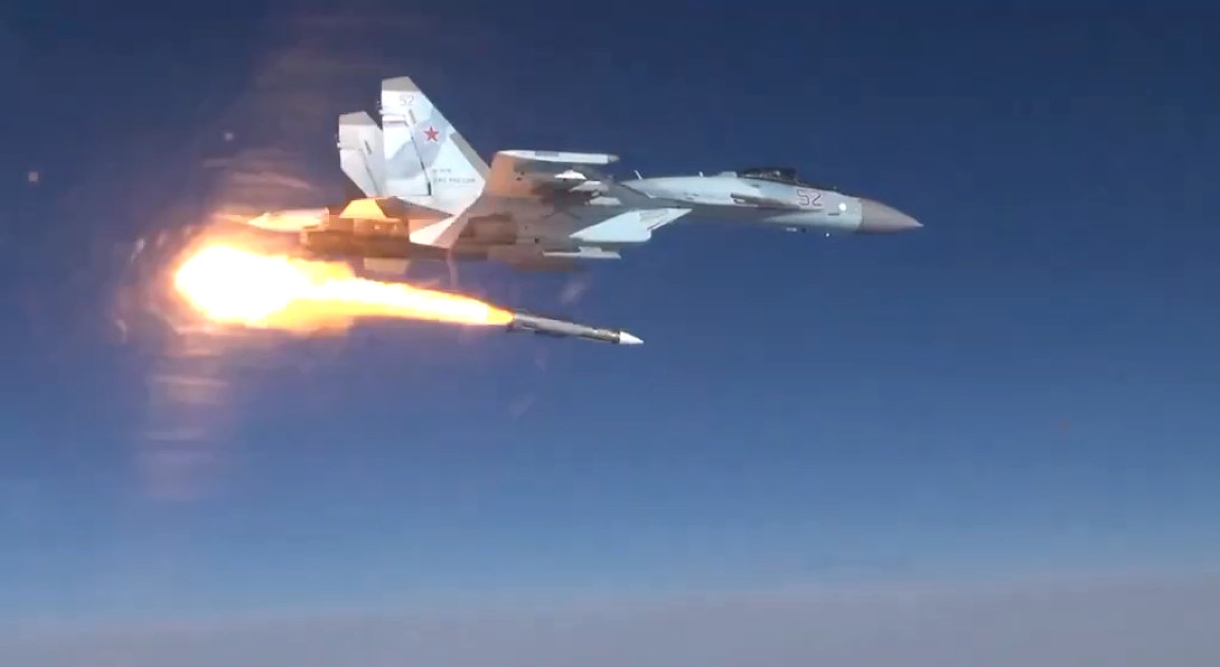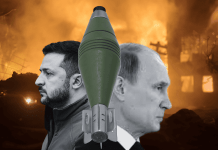The Russian Aerospace Forces (RuAF) struck painful blows on Ukrainian forces on November 24 and 25, 2022.
About the November 24 strike, the RuMoD said, “As a result of high-precision weaponry strikes by the Russian Air Force against three temporary Polish mercenary units near Velikiye Hutora (Kharkiv region), up to 200 militants have been destroyed.
Powered By Su-35 Fighters, Russia Is ‘Winning In Air,’ But Ukrainians Are Leading On Ground – Ex-US Navy Admiral
“In addition, over a hundred mercenaries of the so-called Foreign Legion, as well as 1 tank, 2 armored combat vehicles, and 8 motor vehicles, have been eliminated by Russian air force high-precision weapons near Seversk and Slovyansk (Donetsk People’s Republic).”
An Izvestia report on the incident showed a RuAF Su-34 fighter being armed with a Kh-29 air-to-surface missile (ASM).
The EurAsian Times had earlier reported that Russia relies heavily on its Kh-29 ASM for precision attacks on Ukraine along the frontline, where it dominates the skies.
The Kh-29 is the perfect weapon for attacking visually observed hardened ground targets, such as big railway and highway bridges, industrial installations, concrete runways, aircraft in reinforced concrete shelters, and hardened defensive positions.
There are two variants of the Kh-29 missile – Kh-29L and Kh-29TE. The Kh-29TE missile is equipped with a passive TV guidance system and the Kh-29L – with a semi-active laser guidance system using reflected laser illumination.
The missiles are armed with high explosive penetrating warheads and an impact target sensor. They are powered by a single-mode solid-fuel rocket engine.
Both TV guidance and semi-active laser homing give the missile pinpoint accuracy. Rocket propulsion gives the missile a lot of momentum, aiding in destruction and penetration. Cruise missiles or kamikaze drones, in contrast, lack the accuracy and the destructive power of the Kh-29.

On November 25, 2022, a Russian Su-35S downed a Ukrainian fighter in a look-down shoot-down attack from medium altitudes.
According to the statement released by the RuMoD, “Fighter crews patrol the airspace 24 hours a day, seven days a week. Their task is to cover bombers and attack aircraft, as well as army helicopters, during air strikes against the AFU military facilities and equipment.
“Within one of the sorties, an enemy aircraft was timely detected and destroyed.”
RuMoD released footage showing a Su-35S shooting down a Ukrainian fighter in look-down shoot-down mode from medium altitudes with RVV-SD (R-77) missiles.
The Su-35S fired two RVV-SD missiles. Based on the upward trajectory of the missiles after launch, they were fired for long range.
The Su-35S fired two RVV-SD missiles. Based on the upward trajectory of the missiles after launch, they were fired from extreme range. pic.twitter.com/0fOl530cTo
— Vijainder K Thakur (@vkthakur) November 26, 2022
Evidently, the RuAF has adopted tactics that facilitate air dominance without putting their fighters in harm’s way. The absence of Su-35 losses, despite the influx of Western AD missile systems & presence of Ukrainian Buk-M2 and S-300, bear testimony to the success of RuAF tactics.
The Su-35S was flying in a configuration that is typical for air dominance – 2xRVV-MD for short-range self-defense, 2xRVV-SD for medium-range air combat, and 1 Kh-31 for attacking any emitting AD radar.
The Su-35S was flying in a configuration that is typical for air dominance – 2xRVV-MD for short range self defense, 2xRVV-SD for medium range air combat and 1 Kh-31 for attacking any emitting AD radar pic.twitter.com/gZhyJpA9I1
— Vijainder K Thakur (@vkthakur) November 26, 2022
The RVV-SD missile used in the shoot-down is designed to engage air targets (fighters, attack aircraft, bombers, helicopters, military transport aircraft, and cruise missiles) from any direction, day or night, against the earth and sea background and in an ECM environment.
It features a multi-channel fire-and-forget engagement capability.
There are two variants of the R-77 missile – RVV-AE and RVV-SD. They differ in size, weight, and range. RVV-AE has a range of 80 km and RVV-SD 110 km.
The missile with a 110-km range features an active radar seeker and a data link updated inertial guidance system, which enables in-flight target lock-on (multichannel capability) and re-targeting of the missile in flight from one target to another. The active radar seeker facilitates fire-and-forget.
A unique feature of the missile is the electrically driven lattice control surfaces near the exhaust instead of traditional fins.
- Vijainder K Thakur is a retired IAF Jaguar pilot. He is also an author, software architect, entrepreneur, and military analyst. VIEWS PERSONAL
- Follow the author @vkthakur




